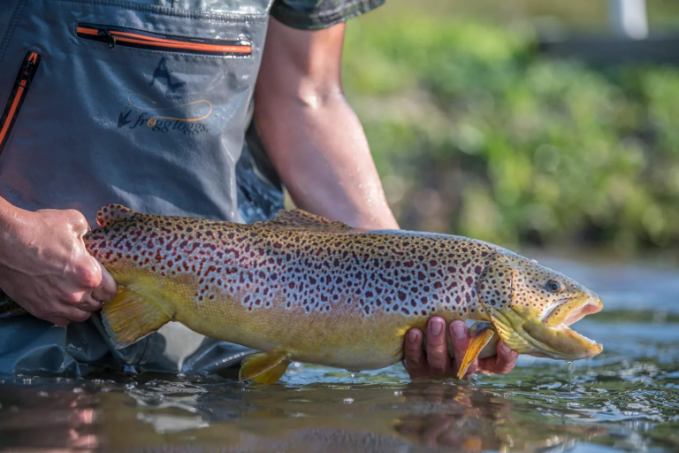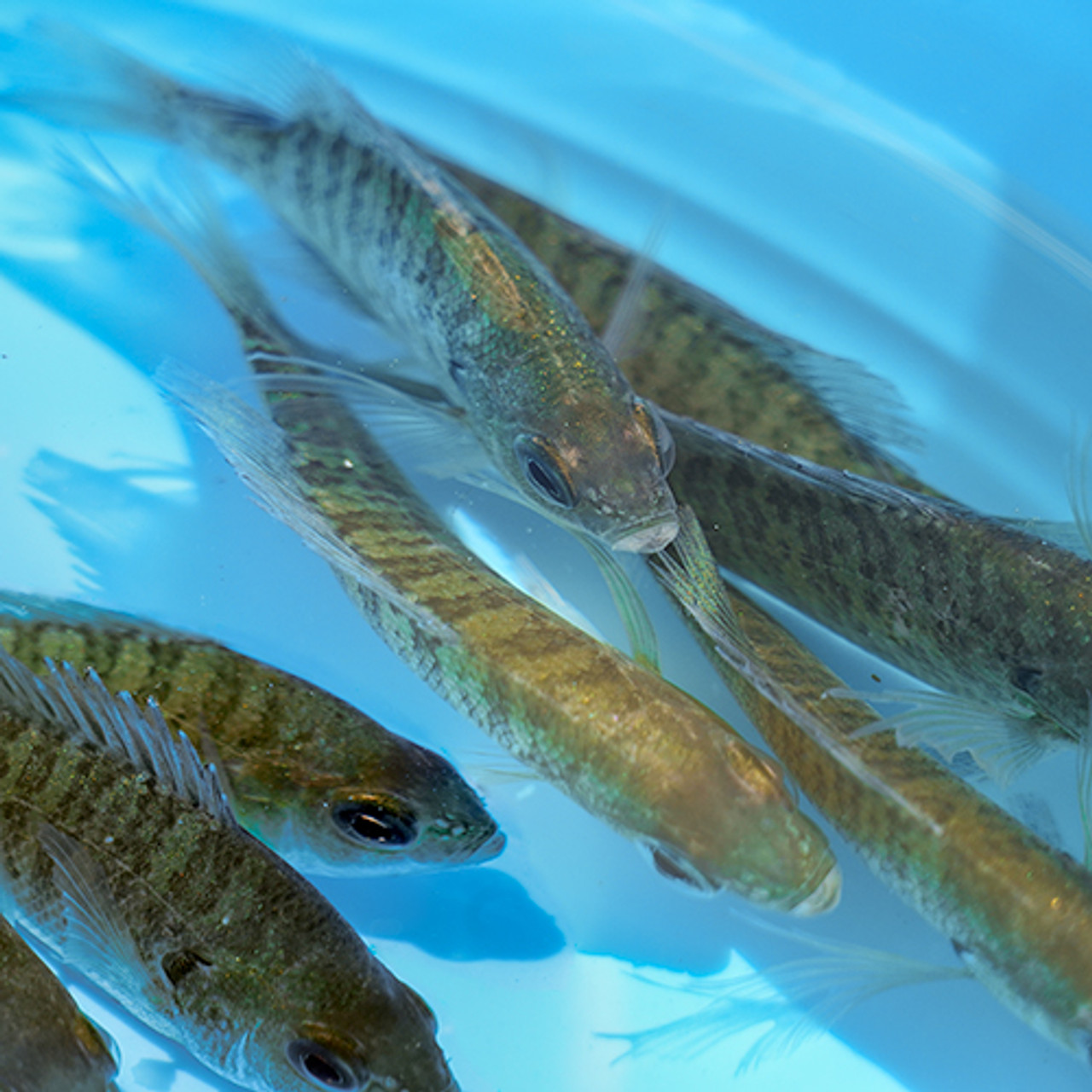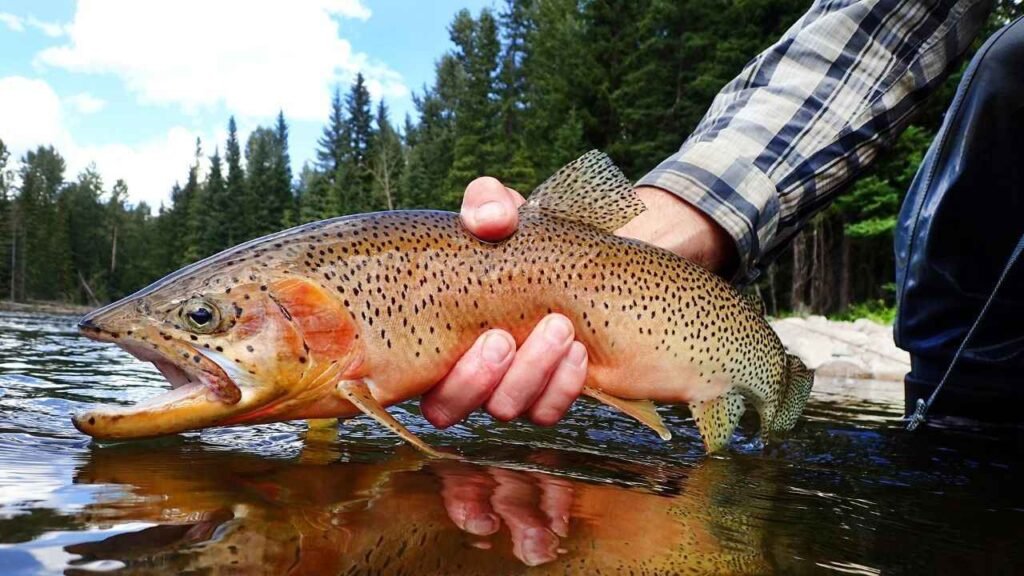Stocking a pond with live trout fish can transform it into a thriving ecosystem. These fish bring life and balance to any water body, making it more enjoyable and sustainable.
Live trout fish are a great choice for pond stocking due to their adaptability and benefits to the aquatic environment. They help control insect populations, improve water quality, and provide recreational fishing opportunities. Stocking your pond with trout can also enhance its aesthetic appeal and promote a healthy habitat for other aquatic species.
Whether you are a fish enthusiast or a pond owner looking to maintain a balanced ecosystem, understanding the benefits and proper methods of stocking your pond with live trout fish is essential. This blog will guide you through the essentials of pond stocking with trout, ensuring a thriving and vibrant aquatic environment.

Credit: bigbrownfish.com
Benefits Of Trout Stocking
Stocking your pond with live trout offers numerous benefits. These fish not only enhance the beauty of your water body but also provide ecological advantages. Let’s explore the key benefits of trout stocking.
Enhanced Water Quality
Trout help maintain cleaner water. They feed on algae and other organic matter, reducing unwanted buildup. This natural cleaning process ensures a healthier pond environment.
Clear water is vital for aquatic life. It supports the growth of beneficial plants and organisms. This creates a balanced ecosystem in your pond.
Natural Pest Control
Trout act as natural pest controllers. They consume insects, larvae, and other pests. This helps reduce the need for chemical treatments.
By eating pests, trout protect your pond from infestations. This keeps the water healthier and safer for other fish and wildlife.
In summary, stocking your pond with live trout improves water quality and provides natural pest control. These benefits make trout an excellent choice for pond stocking.

Credit: shop.naturalwaterscapes.com
Choosing The Right Trout Species
Stocking your pond with trout can be a rewarding experience. Choosing the right species is key. Different species have unique needs and benefits. Here, we’ll cover Rainbow Trout and Brook Trout.
Rainbow Trout
Rainbow Trout are popular for pond stocking. They are hardy and adapt well. This species thrives in a variety of water conditions. They are known for their beautiful colors and patterns.
| Feature | Details |
|---|---|
| Temperature | 50-65°F |
| Diet | Insects, small fish |
| Growth Rate | Fast |
Rainbow Trout grow quickly, reaching up to 12 inches in one year. They are also easy to feed. They enjoy both insects and small fish.
Brook Trout
Brook Trout, also known as Speckled Trout, are another great choice. They prefer cooler water and are native to North America. These trout are smaller but just as beautiful.
| Feature | Details |
|---|---|
| Temperature | 45-60°F |
| Diet | Insects, crustaceans |
| Growth Rate | Moderate |
Brook Trout grow at a moderate rate. They are best suited for ponds with good water quality. Their diet includes insects and crustaceans. They are resilient and beautiful, making them a favorite for many pond owners.
- Rainbow Trout: Hardy, fast-growing, adaptable.
- Brook Trout: Cooler water, moderate growth, native species.
Both species offer unique advantages. Consider water conditions and personal preferences when making your choice.
Preparing Your Pond
Stocking a pond with live trout fish is an exciting task. But, it requires preparation. Ensuring the pond is ready helps fish thrive. Below are key steps to prepare your pond for live trout.
Water Conditions
Trout fish need clean, cold water. The water should be between 50°F and 65°F. Regularly check the water temperature. Use a thermometer for accuracy. Clean water is also essential. Avoid pollutants and runoff. Test the water’s pH level. Trout prefer a pH between 6.5 and 8.0. Use a pH testing kit for this purpose. Keep the water oxygenated. Install an aeration system if needed.
Pond Size And Depth
Pond size and depth are crucial for trout health. The pond should be at least 1 acre in size. This provides enough space for the fish. Depth is also important. The pond should be at least 8 feet deep. Deeper ponds help maintain cooler temperatures. This is vital for trout. Shallow ponds can get too warm in summer.
| Factor | Requirement |
|---|---|
| Water Temperature | 50°F – 65°F |
| pH Level | 6.5 – 8.0 |
| Pond Size | At least 1 acre |
| Pond Depth | At least 8 feet |
Follow these guidelines for a healthy trout pond. Proper water conditions and pond size are key. With preparation, your trout will thrive.
Sourcing Live Trout
Stocking your pond with live trout is an exciting process. The key to success is finding the right source. You want healthy fish that will thrive in your pond. This involves choosing reputable suppliers and ensuring proper transportation.
Reputable Suppliers
First, you need a reputable supplier. Look for suppliers with positive reviews. Ensure they have experience in providing live trout for pond stocking. Ask for references from other pond owners.
Check if the supplier follows health regulations and best practices. This ensures the trout are healthy and disease-free. You should also verify the supplier’s certifications and licenses.
Here is a quick checklist to help you choose:
- Positive customer reviews
- Experience in pond stocking
- Follows health regulations
- Certifications and licenses
Transportation Tips
Transporting live trout needs careful planning. The goal is to reduce stress on the fish. Here are some tips:
- Use oxygenated water to keep the trout healthy.
- Transport during cooler temperatures to avoid heat stress.
- Avoid overcrowding in transport containers.
- Minimize the time the trout spend in transit.
Proper transportation ensures the trout arrive in good condition. This increases their chances of thriving in your pond.
Introducing Trout To Your Pond
Stocking your pond with live trout can enhance its ecosystem. These fish not only add beauty but also help control insect populations. To ensure their survival and growth, proper introduction is crucial.
Acclimatization Process
Trout are sensitive to sudden changes in water conditions. Before releasing them into your pond, acclimatize them to the new environment. Start by floating the bag containing the trout in your pond for 15-20 minutes. This step helps equalize the temperature between the bag and pond water.
Next, gradually add small amounts of pond water into the bag every 5 minutes. Continue this for at least 30 minutes. This slow process allows the fish to adjust to the pond’s pH and other water parameters. Finally, gently release the trout into the pond.
Optimal Release Time
Timing is essential when introducing trout to your pond. The best time for release is during cooler parts of the day. Early morning or late evening is ideal. Avoid releasing trout during extreme temperatures or in the middle of the day.
Check the water temperature. Trout thrive in water temperatures between 50°F and 60°F. If the water is too warm, consider waiting for a cooler day.
| Time of Day | Recommended Action |
|---|---|
| Early Morning | Best time for release |
| Late Evening | Best time for release |
| Midday | Avoid releasing trout |
Following these steps ensures a smoother transition for your trout. It increases their chances of thriving in the new environment.

Credit: bigbrownfish.com
Feeding And Nutrition
Feeding and nutrition play a vital role in maintaining healthy trout in your pond. A balanced diet ensures the fish grow well and stay disease-free. Understanding their natural food sources and how to supplement their diet is key.
Natural Food Sources
Trout are naturally inclined to feed on a variety of organisms found in ponds. These include:
- Insects: Mayflies, caddisflies, and other aquatic insects.
- Small Fish: Minnows and other smaller fish species.
- Crustaceans: Crayfish and other small crustaceans.
- Plankton: Microscopic plants and animals.
Maintaining a natural habitat in your pond can help sustain these food sources. This will reduce the need for supplemental feeding.
Supplemental Feeding
While natural food sources are essential, supplemental feeding ensures trout receive all necessary nutrients. Here are some tips for effective supplemental feeding:
- Choose High-Quality Feed: Look for feed specifically formulated for trout. It should include protein, fat, vitamins, and minerals.
- Feed at Regular Intervals: Feeding twice a day is ideal. Morning and late afternoon are the best times.
- Monitor Feeding Behavior: Observe how much the fish eat. Adjust the amount of feed based on their consumption.
- Avoid Overfeeding: Excess feed can pollute the water and cause health issues for the fish.
Supplemental feeding, when done correctly, boosts growth and keeps the trout healthy.
Below is a sample feeding schedule:
| Time | Amount of Feed |
|---|---|
| Morning (8 AM) | 2% of total fish weight |
| Afternoon (4 PM) | 2% of total fish weight |
Remember, a balanced diet is crucial. It ensures your trout thrive in the pond environment.
Monitoring Trout Health
Monitoring trout health is crucial for maintaining a thriving pond ecosystem. Healthy trout ensure balanced water quality and support other aquatic life. Regular checks help detect issues early, ensuring prompt action and preventing widespread problems.
Signs Of Healthy Trout
Healthy trout exhibit several key signs. These include:
- Active Swimming: Trout should swim energetically and not appear lethargic.
- Bright Coloration: Their colors should be vibrant and not faded.
- Clear Eyes: The eyes should be bright and clear, not cloudy or sunken.
- Smooth Scales: Scales should be intact and smooth, without any lesions.
- Good Appetite: Healthy trout eat eagerly during feeding times.
Common Diseases
Trout are susceptible to various diseases. Knowing these can help in early detection and treatment.
| Disease | Symptoms | Prevention |
|---|---|---|
| Ich | White spots on skin, rubbing against objects | Maintain clean water, quarantine new fish |
| Columnaris | Frayed fins, white patches on skin | Reduce stress, improve water quality |
| Fin Rot | Damaged fins, discolored edges | Maintain good water conditions, avoid overcrowding |
Regular monitoring and prompt action are key to keeping your trout healthy. Ensure proper water conditions and feeding habits. This helps in maintaining a thriving pond ecosystem.
Maintaining A Balanced Ecosystem
Stocking your pond with live trout fish is an excellent way to enhance its beauty and functionality. But it’s crucial to maintain a balanced ecosystem. This ensures your pond remains healthy and vibrant. A balanced ecosystem supports the growth of trout and other aquatic life. Two critical aspects of this balance are predator control and maintaining the right plant and fish balance.
Predator Control
Predators can disrupt the balance of your pond’s ecosystem. Birds, raccoons, and larger fish often prey on trout. You need to manage these predators to protect your trout population.
- Fencing: Install a fence around your pond to keep out land predators.
- Netting: Use nets to cover your pond, preventing birds from accessing the fish.
- Habitat Design: Design your pond to include hiding spots for trout. Rocks and submerged plants offer excellent cover.
Regular monitoring is essential. Check for signs of predator activity and take action as needed.
Plant And Fish Balance
A healthy pond requires a balance between plants and fish. Plants provide oxygen and shelter for the fish. They also help control algae growth.
| Plant Type | Benefit |
|---|---|
| Submerged Plants | Increase oxygen levels and provide cover. |
| Floating Plants | Reduce sunlight penetration, controlling algae. |
Introduce plants gradually. This allows the ecosystem to adjust. Monitor the plant growth and prune as necessary.
Fish balance is equally important. Too many fish can lead to overpopulation and stress. Follow these tips:
- Stock your pond based on its size and capacity.
- Introduce fish in stages to avoid sudden changes.
- Regularly check the health and growth of your fish.
Maintaining a balanced ecosystem ensures a thriving pond. It supports the health and growth of your live trout fish.
Frequently Asked Questions
What Are The Benefits Of Pond Stocking With Live Trout?
Stocking your pond with live trout boosts biodiversity. It enhances recreational fishing opportunities. Trout also help control insect populations in your pond.
How Many Trout Should I Stock In My Pond?
The ideal number depends on your pond size. Typically, stock 300-500 trout per acre. Always consult a pond management expert.
What Is The Best Time To Stock Trout?
The best time to stock trout is in spring or fall. This ensures optimal water temperatures and better survival rates.
How Do I Prepare My Pond For Trout Stocking?
Ensure the pond has clean, oxygen-rich water. Check the pH levels and remove potential predators. Maintain proper vegetation for shelter.
Conclusion
Stocking your pond with live trout ensures a vibrant, healthy ecosystem. Trout thrive in clean, oxygen-rich water, promoting biodiversity. They control insect populations, benefiting your pond’s environment. Regular monitoring and proper care keep your fish healthy. Enjoy the beauty and balance that trout bring to your pond.
Happy pond stocking!



